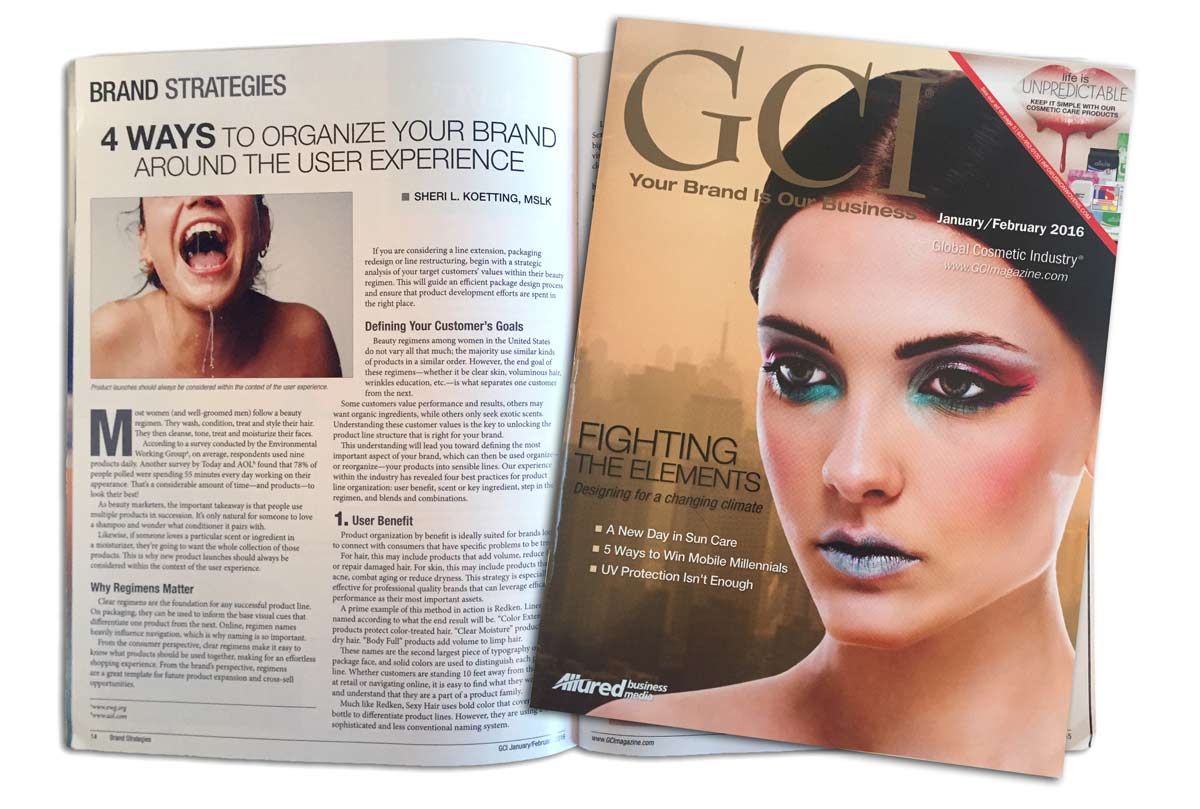
4 Ways to Organize Your Brand around the User Experience
Brands want their customers to be able to choose products that are right for them, and keep them coming back for more. Smart brands do so by basing their experience around the user’s experience. Sheri Koetting was invited by GCI Magazine in the January 2016 issue to share some of the ways brands can best optimize their products to already-existing norms within user experiences.
Most women (and well-groomed men) follow a beauty regimen. They wash, condition, treat and style their hair. They then cleanse, tone, treat and moisturize their faces.
According to a survey conducted by the Environmental Working Group, on average, respondents used nine products daily. Another survey by Today and AOL found that 78% of people polled were spending 55 minutes every day working on their appearance. That’s a considerable amount of time—and products—to look their best!
Previously: Branding and Rebranding: Order of Implementation
As beauty marketers, the important takeaway is that people use multiple products in succession. It’s only natural for someone to love a shampoo and wonder what conditioner it pairs with. Likewise, if someone loves a particular scent or ingredient in a moisturizer, they’re going to want the whole collection of those products. This is why new product launches should always be considered within the context of the user experience.
Further reading: A Well-targeted Market
Why Regimens Matter
Clear regimens are the foundation for any successful product line. On packaging, they can be used to inform the base visual cues that differentiate one product from the next. Online, regimen names heavily influence navigation, which is why naming is so important.
From the consumer perspective, clear regimens make it easy to know what products should be used together, making for an effortless shopping experience. From the brand’s perspective, regimens are a great template for future product expansion and cross-sell opportunities.
If you are considering a line extension, packaging redesign or line restructuring, begin with a strategic analysis of your target customers’ values within their beauty regimen. This will guide an efficient package design process and ensure that product development efforts are spent in the right place.
Defining Your Customer’s Goals
Beauty regimens among women in the United States do not vary all that much; the majority use similar kinds of products in a similar order. However, the end goal of these regimens—whether it be clear skin, voluminous hair, wrinkles education, etc.—is what separates one customer from the next.
Some customers value performance and results, others may want organic ingredients, while others only seek exotic scents. Understanding these customer values is the key to unlocking the product line structure that is right for your brand.
This understanding will lead you toward defining the most important aspect of your brand, which can then be used organize—or reorganize—your products into sensible lines. Our experience within the industry has revealed four best practices for product line organization: user benefit, scent or key ingredient, step in the regimen, and blends and combinations.
1. User Benefit
Product organization by benefit is ideally suited for brands looking to connect with consumers that have specific problems to be treated.
For hair, this may include products that add volume, reduce frizz or repair damaged hair. For skin, this may include products that treat acne, combat aging or reduce dryness. This strategy is especially effective for professional quality brands that can leverage efficacy and performance as their most important assets.
A prime example of this method in action is Redken. Lines are named according to what the end result will be. “Color Extend” products protect color-treated hair. “Clear Moisture” products repair dry hair. “Body Full” products add volume to limp hair.
These names are the second largest piece of typography on the package face, and solid colors are used to distinguish each product line. Whether customers are standing 10 feet away from the products at retail or navigating online, it is easy to find what they want quickly and understand that they are a part of a product family.
Much like Redken, Sexy Hair uses bold color that covers the entire bottle to differentiate product lines. However, they are using a more sophisticated and less conventional naming system. Line names are cleverly woven into the brand name, such as Big Sexy Hair, Curly Sexy Hair and Smooth Sexy Hair. These names are big and bold, running down the side of the bottles. The result is a visually arresting system that captures consumer attention and is clear in communicating what each of the products do.
Dermalogica is a clinical skin care brand that also organizes by benefit. While their spare, no-frills design approach is typical of professional skin care packaging, their line organization and selling strategies showcase a clever marketing approach.
They have seven product regimens, including AGE smart, Ultracalming and mediBac clearing. Each product line name conveys a quiet gravitas, giving a sense of medical confidence and efficacy. These products are sold individually and as kits, which further reinforces the notion that customers need all products within a collection to achieve the desired result.
2. Scent or Key Ingredient
This method of organization is most common among natural brands with formulations that can leverage ingredients as a key point of difference. It can also be useful for brands that do not have research to support performance claims, necessitating that other aspects of the product line be dialed up.
Consumers typically crave products with a distinctive fragrance, and it can often be the most memorable aspect of a product experience. After all, scents remain with you long after the product has been used.
Likewise, consumers crave ingredients that they can feel good about putting on their bodies. Brands that have organic ingredients or trendy ingredients, such as açai, pomegranate or goji berry, should definitely consider this method as a viable option.
A great example of this method in action is Pacifica, a brand that prides itself on vegan ingredients. These become the basis of a lively graphic system that distinguishes one product from the next.
Each product feels like a vacation in a bottle, with a distinctive name that elevates the ingredient by tying it to an exotic getaway—Brazilian Mango Grapefruit, Indian Coconut Nectar and Tuscan Blood Orange. Each of these ingredients fits into a clear regimen consisting of a perfume, body butter, body wash and soap.
Pacifica takes it one step further by extending their ingredients to home products, such as candles and reed diffusers, making them a true lifestyle brand. While their product line is large, Pacifica’s ingredient-focused system makes it easy to navigate and leaves customers wanting the entire collection.
3. Step in the Regimen
This method of organization is useful for brands who have focused product lines that are all about achieving a single desired result. It comes with its own unique connotations, instantly conveying that the products are part of a sequence, and that you need the whole collection to reap the benefits. While less popular than the other two methods, brands that require a lot of product education may find this to be the perfect solution.
A quintessential example is Clinique’s three-step skin care system. The brand actually pioneered this concept when it launched in 1968, following a Vogue article that talked about how great skin could be achieved through a proper regimen.
Clinique has one simple skin regimen: cleanse, exfoliate and moisturize. It is clear and memorable, reinforced in all of their messaging and marketing materials, and has a proven 45-plus-year track record.
On top of this system, Clinique customers can also select one of four skin types. By contrast, Verso is a small skin care line with a single goal: Reverse the aging process. This is supported in everything from the name and messaging to the large backward numbers, which are the dominant graphic element on the package.
4. Blends and Combinations
In many cases, one organizational method may not naturally fit a product line, necessitating that different systems be used together. We have found that the best practice is to have a base differentiator, such as scent or ingredient, and then have other systems be treated as secondary and tertiary levels within the hierarchy.
A great example of this is the skin care brand Korres. The brand first organizes its products by ingredient, such as black pine, wild rose and Greek yogurt. Each of these ingredients is tied to a specific benefit.
All black pine products help firm, all wild rose products help brighten, etc. By contrast, Herbal Essences takes more of a sensory approach, organizing each product by overall benefit, such as illuminating or rejuvenating. Specific ingredient combinations are tied to each of these benefits and are secondary in the hierarchy.
Adopting Regimen-based Thinking These methods of product line organization are relevant for brands both big and small, new and existing alike. New brands have the opportunity to consider both consumers and retail buyers right from the start.
Study how products are displayed at the retailers you are considering. Adjacency at retail can help inform which products should part of a regimen. Then, balance this with an understanding of your target customer’s lifestyle and values. Creating products at the intersection of consumer and retailer preferences is always a winning strategy.
If you’re an existing brand, your current architecture may not easily allow for product regimens. This is okay, as brands are constantly evolving, making change inevitable.
Beauty brands tend to update their packaging every two to three years. Line extensions and new product launches can quickly erode the clarity of the brand as a whole if a solid system isn’t there to begin with.
This is why product line structures should be routinely re-examined. Of course, the reasons for change should be rooted in customer feedback.
Sending out customer surveys and conducting focus groups can help set the course. The most important data to be gained from these sessions would be a true sense of what your customers value in their beauty regimens, pain points and favorite products.
At the end of the day, you want your customers to be able to effortlessly self-select products that are right for them, and keep them coming back for more.
Read original article here:
http://www.gcimagazine.com/business/marketing/4-Ways-to-Organize-Your-Brand-around-the-User-Experience-369134741.html#sthash.8lmftlqw.dpuf
MSLK was recently recognized by DesignRush as a top Cosmetic Package Design Company .

